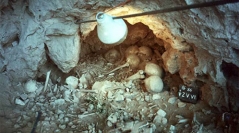

 Comptes Rendus Palevol
5 (1-2) - Pages 429-440
Comptes Rendus Palevol
5 (1-2) - Pages 429-440The symbolic universe of Mechta-Afalou’s men is very little known, as Prehistory was mostly interested in reconstituting industrial assemblages and technological modes of their obtention. We will try in this paper, on the basis of the last works of Afalou Bou Rhummel, to accede to some of those activities indirectly bound to subsistence. We will first focus on the longevity of the human occupation of this important rock shelter and of the neighbouring shelters inscribed within the bio-geographical unit of the coastal mountainous massif of the Babors. The territory has been occupied continuously by Iberomaurisian populations during more than eight millennia, just before Holocene. Access to food resources, requesting the numerous strata of nature, departing from fishing art possibilities and going through the universe of molluscs and different varieties of vertebrates, seems to have been controlled by those populations that have, nonetheless, shown a particular preference to the wild ship (Ammotragus lervia). Populations have invested the different areas of the territory with different significance. To grasp each subtlety, far from it, is still not yet possible. Nevertheless, we ought to seek for the significance of choosing the Afalou Bou Rhummel shelter for the establishment of a necropolis gathering several tens of individuals, such as the westward and almost contemporary necropolises of Columnata and Taforalt. Those places were certainly meaningful enough for everyone to have wished to get buried there or at least not elsewhere, in other habitats even occupied at the same epoch. It happens that the shelter has also given, in the form of backed clay statuettes, the oldest artistic manifestations known up to now in northern Africa. This second fact represents the meeting point, in a living place, of two prominent facts of recent prehistory both characterising modern Men: the metaphysical fact and the aesthetic fact.
Rock shelter, necropolis, inhumation mode, figurative art, symbolic behaviour, North Africa